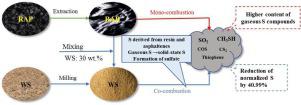Journal of Hazardous Materials ( IF 13.6 ) Pub Date : 2020-09-19 , DOI: 10.1016/j.jhazmat.2020.123911 Teng Wang , Hao Rong , Si Chen , Yi Zhou , Jinping Li , Yue Xiao , Yongjie Xue

|
Reclaimed asphalt binder (RAB) releases large amounts ·of hazardous sulfur-containing gases during combustion. This study attempts to introduce wood sawdust (WS) as an in-situ inhibitor of sulfur release during the combustion of refuse-derived fuel (RDF) blended with RAB-WS. The combustion characteristics, gaseous sulfur-containing products, interactions and combustion kinetics of RDF were investigated through thermogravimetry and mass spectrometry (TG-MS), and the mechanisms on migration and distribution of sulfur were revealed. Results indicated that WS additive inhibits the volatilization of light components and promotes the degradation of macromolecular components. WS addition improved the combustibility, burnout performance and combustion stability of RAB. The sulfur release of RAB-based RDF was mainly derived from resins and asphaltenes. WS addition generally decreased all gaseous sulfur-containing compounds (CH3SH, COS, SO2, CS2 and thiophene). Interactions between RAB and WS restrained all sulfur-containing gas emissions, and the normalized sulfur inhibition ratio reached 40.99%. The Sarink and DAEM models could well describe the kinetic process of the co-combustion of RAB and WS. WS addition led to a decrease in activation energy, namely, it lowered the reaction barrier. Sulfur could be retained in-situ into incineration residue through the formation of sulfate minerals during the co-combustion of RAB and WS.
中文翻译:

TG - MS研究再生沥青结合料与木屑的共燃过程中原位硫的保留
再生的沥青粘合剂(RAB)在燃烧过程中会释放大量有害的含硫气体。这项研究试图引入木屑(WS)作为原位与RAB-WS混合的垃圾衍生燃料(RDF)燃烧过程中硫释放的抑制剂。通过热重分析和质谱分析(TG-MS)研究了RDF的燃烧特性,气态含硫产物,相互作用和燃烧动力学,揭示了硫的迁移和分布机理。结果表明,WS添加剂抑制了轻组分的挥发并促进了大分子组分的降解。WS的添加改善了RAB的可燃性,燃尽性能和燃烧稳定性。RAB基RDF的硫释放主要来自树脂和沥青质。WS添加通常会降低所有气态含硫化合物(CH 3 SH,COS,SO 2,CS 2和噻吩)。RAB和WS之间的相互作用抑制了所有含硫气体的排放,归一化硫抑制率达到40.99%。Sarink和DAEM模型可以很好地描述RAB和WS共同燃烧的动力学过程。WS的加入导致活化能降低,即降低了反应势垒。在RAB和WS共同燃烧过程中,硫可以通过形成硫酸盐矿物而原位保留在焚烧残渣中。



























 京公网安备 11010802027423号
京公网安备 11010802027423号